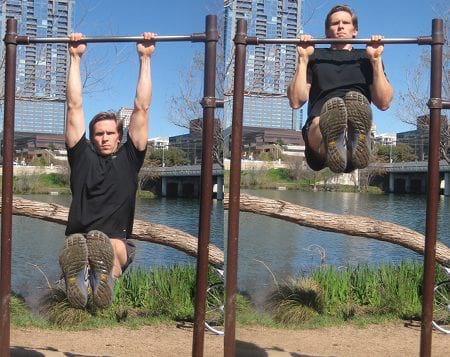Video Demonstration
Use this move to work your back biceps and abdominals at the same time.
The L-Sit Pull-Up is a challenging variation of the traditional pull-up.
With this variation, your legs get raised in front of you causing the center point of gravity to change. This shift in gravity makes the L Pull-Up more difficult.
Having your legs held up and raised in front of you also creates an isometric contraction in your abdominals.
Another benefit to having your legs are held out at 90 degrees is that you will not be able to use kipping or jerking to cheat.
When doing this lift, you need to pay attention to how fast you are raising and lowering your body. Each rep should get done in a slow and controlled manner.
L-Sit Pull-Up How to Guide
Image Example

Step by Step Description
Step 1: Grab the pull-up bar using an overhand grip (palms of your hands facing away from your body). Your hands can be placed anywhere from shoulder width to about twice your shoulder width. The width you select depends on the back and bicep muscles you want to give attention to (see muscles worked for more details). Have your arms fully extended, so you are in the bottom position of the pull-up.
Step 2: Pull your shoulders back and push out your chest. Bend at your hips and raise your legs until they are parallel to the ground (your body should now be in an L shape with your upper body vertical and the legs out horizontally). You are now in the starting position.
Step 3: Exhale and raise your body up by moving your shoulders and upper arms down and back. Squeeze your back when you are at the top of the Pull-Up.
Step 4: Hold the contracted position for a second. Inhale and slowly lower your body back down to the starting position where your arms are fully extended. Do not just drop your body back down.
Repeat the movement for the desired number of repetitions.
L-Hang Pull Up Progression
Difficulty Level
The L Sit-Up gets rated as an advanced calisthenics exercise.
Equipment Required
To perform this exercise, you will need a pull-up bar.
Muscles Worked
Multiple muscle groups get worked by this lift.
The primary muscles used are your Traps, Lats, Abdominals, and the Obliques. Your Biceps and Forearms also get used when you are performing this lift.
Keep your legs raised the entire time you do this exercise to keep your core under constant pressure.
If you use a wide grip when performing this exercise, there will be a higher focus placed on the Lats (helping to create a V-Taper appearance).
The closer you place your arms closer together the larger the focus on your biceps will be. To hit the biceps even harder use a chin up grip (palms facing forward) instead.
Benefits
Kipping and jerking your body is harder in this position. This position reduces the ability for someone to cheat when performing this Pull-Up variation.
Since more muscle fibers are used compared to the traditional pull-up, you will burn a higher amount of calories when you do it.
Training Tips
If you cannot perform L Sit-Ups yet, you should use the raised knee version instead. Using the raised knee version will help you to increase your core strength.
For the Raised Knee Pull-Up version your thighs will be parallel to the floor, and your shins will be vertical like the upper body.
After you can perform the Raised Knee version, it is time to move on to the alternate leg version to keep progressing towards a true L-Sit.
To do this version you need to keep one leg straight, and the other knee bent. When using this one make sure to alternate the leg raised, this will ensure you are evenly building your abdominal strength.
If you want to make this exercise even more challenging, you have two options. You can either hold a weight between your feet or use ankle weight cuffs.
If you are having difficulty holding onto the bar, you need to add some additional grip strengthening exercises into your training routine.
Inclosing
The L Pull-Up is a useful variation that adds some core training to the lift.
It will help you to burn a higher number of calories and gets commonly used in many CrossFit training routines.
If you cannot perform this lift yet, you should start with one of the simpler variations outlined above.
Keep increasing the number of repetitions and slowly progress to the L Pull-Up.
You may also like
Burpee Pull-Up Exercise Guide
Recon Ron Pull-Up Program
The Armstrong Pull-Up Program
Looking to gain more strength or lose some weight? We offer free fitness tools to help you reach your fitness goals. Register for free while we are in beta and get free lifetime access to our fitness tools that include an easy to use Calorie Counter, High-Intensity Interval Timer, Multiple Fitness Calculators and our Exercise Logger.